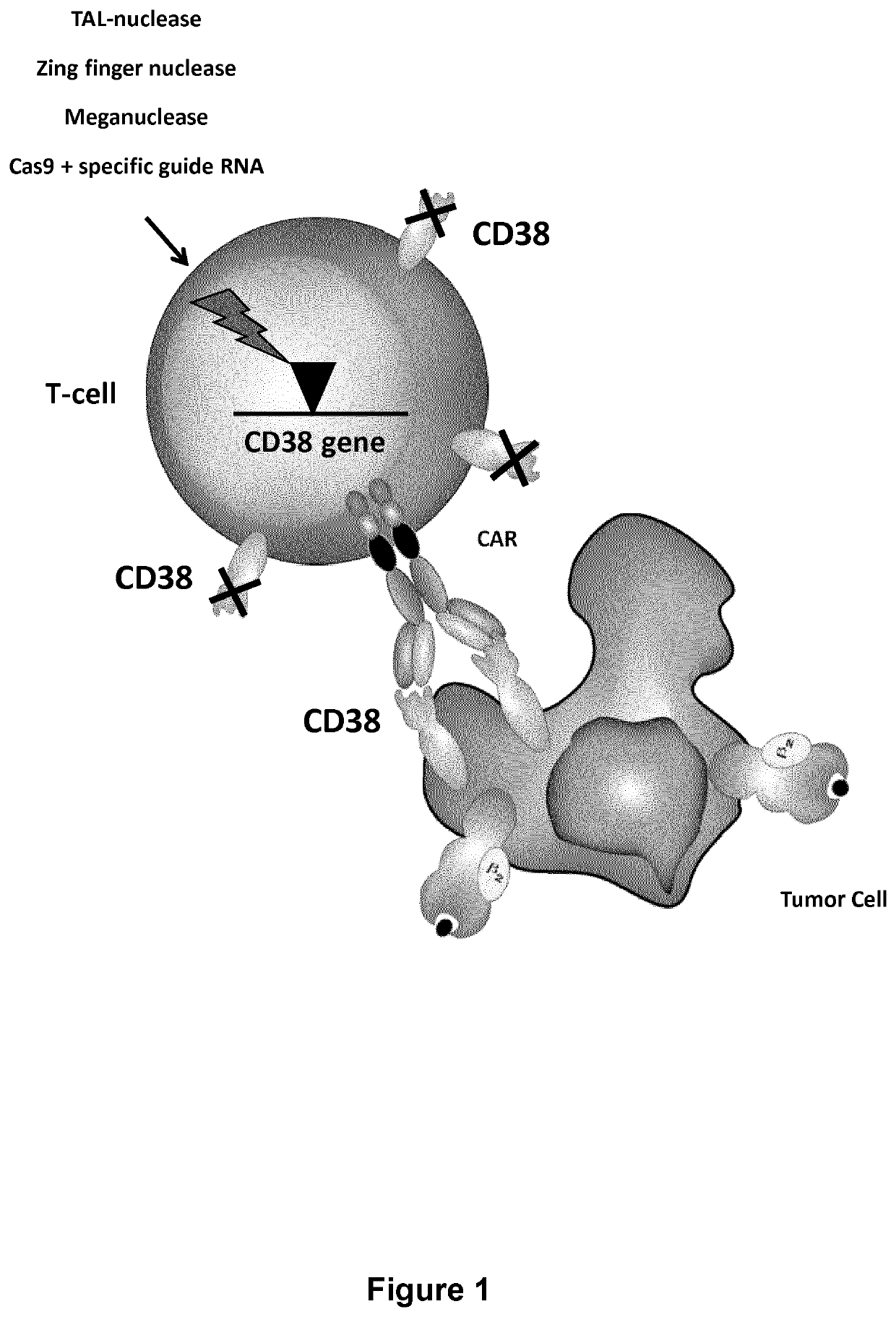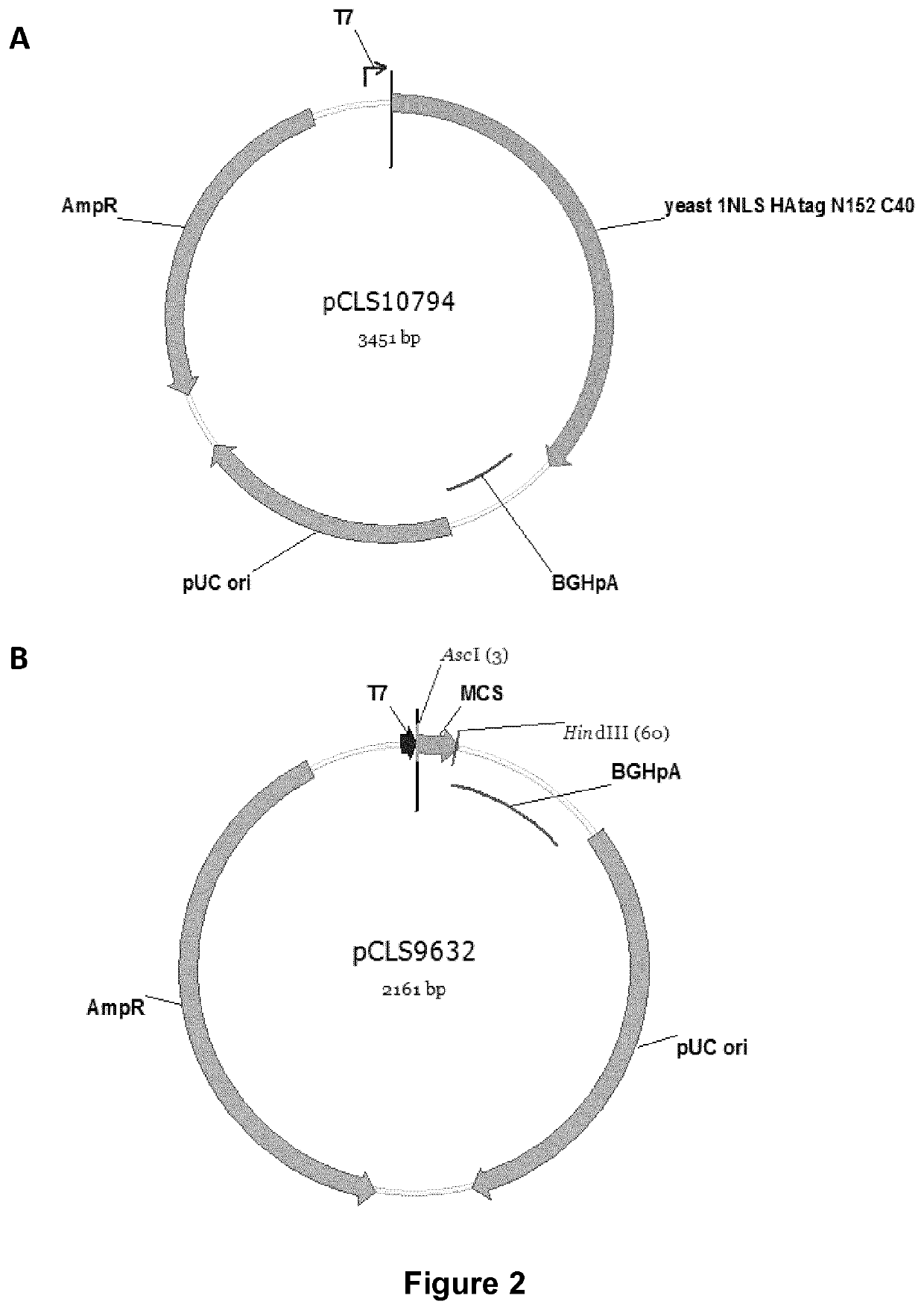Cells for immunotherapy engineered for targeting CD38 antigen and for CD38 gene inactivation
a technology of immunotherapy and cells, applied in the direction of specific cell targeting, genetically modified cells, antibody medical ingredients, etc., can solve the problems of inability to provide prolonged expansion and anti-tumor activity in vivo, degraded immune function, and low number of patient's lymphocytes, so as to reduce the risk
- Summary
- Abstract
- Description
- Claims
- Application Information
AI Technical Summary
Benefits of technology
Problems solved by technology
Method used
Image
Examples
example 1
ion of CD38 Antigen in T Cells by Knock-Out (KO) Using TALE Nuclease
[0590]CD38 is also highly expressed by activated T cells. CD38 expression by T cells after activation with CD3 / CD28 beads and IL-2 was analyzed by FACS every 3-4 days for 17 days (FIG. 3A). It was observed that more than 90% of T cells express CD38 between day 6 and day 17 after activation (FIG. 3B).
[0591]Thus in order to avoid killing of activated T cells by anti-CD38 CAR+ T cells, CD38 surface expression in T cells needs to be prevented. This may be accomplished by the inactivation of the CD38 gene using TALE-nucleases. The experiment was performed as presented in FIG. 4A.
[0592]Heterodimeric TALE-nucleases targeting two 17-pb long sequences separated by a 13-pb spacer within the CD38 gene were designed and produced. Each half target is recognized by repeats of the half TALE-nucleases listed in the Table 4 and FIG. 5.
[0593]Each TALE-nuclease construct was subcloned using restriction enzyme digestion in a mammalian ...
example 2
Anti-CD38 CARs Activity after mRNA Transfection in WT T Cells
[0597]CAR Structure
[0598]Eight pairs of scFvs have been tested, their sequences SEQ ID NO: 10 to 73 including their corresponding CDRs are presented in Table 2.
[0599]For each pair of scFvs, 3 different CARs constructs have been designed with the 41BB costimulatory domain, the CD3 activation domain, the CD8α transmembrane domain and 3 different hinges of sequences SEQ ID NO: 76, 77 and 78) respectively:
[0600]V1: FcεRIIIα hinge
[0601]V2: CD8α hinge
[0602]V3: IgG1 hinge.
[0603]The FIG. 9 and FIG. 2A shows respectively the name of plasmids of the different versions of the CAR created for the subcloning and the one used as backbone. Also the value of Kd for their respective scFvs are provided.
[0604]The Table 1 shows the sequences SEQ ID NO: 82 to 105 for all the 24 different anti-CD38 CARs (8 pairs of scFv×3 versions V1, V2& V3) and of their constituents (except scFvs presented in Table 2).
[0605]Selection of Target Cells
[0606]The ...
example 3
n of the Effect of CD38 KO and Purification of CD38 Negative T Cells on the Activity of a Serial Anti-CD38 CARs Obtained by mRNA Transfection
[0620]i. Comparison CAR mRNA Screening in WT / CD38-Deficient / Purified CD38 Deficient T Cells
[0621]T cells were purified from buffy coat samples and activated using anti-CD3 / CD28 coated beads (time scale of the experiment is presented in FIG. 4B). Cells were transfected 12 days after activation with 15 μg of mRNA encoding anti-CD38 CAR and 24h after CAR mRNA transfection, a significant mortality of T cells was observed.
[0622]The CD38 KO and CD38 negative purification has been tested and evaluated. CD38-1 TALEN mRNA was transfected (or not) in T cells at day 4 after activation with anti-CD3 / CD28 coated beads. 6 days after CD38 negative cells were purified (or not) by using magnetic separation (Miltenyi's protocol). The day after, CAR mRNAs were transfected. The CAR expression and degranulation capacity of CART cells were assessed 24 hours after th...
PUM
| Property | Measurement | Unit |
|---|---|---|
| temperature | aaaaa | aaaaa |
| time | aaaaa | aaaaa |
| time | aaaaa | aaaaa |
Abstract
Description
Claims
Application Information
 Login to View More
Login to View More - R&D
- Intellectual Property
- Life Sciences
- Materials
- Tech Scout
- Unparalleled Data Quality
- Higher Quality Content
- 60% Fewer Hallucinations
Browse by: Latest US Patents, China's latest patents, Technical Efficacy Thesaurus, Application Domain, Technology Topic, Popular Technical Reports.
© 2025 PatSnap. All rights reserved.Legal|Privacy policy|Modern Slavery Act Transparency Statement|Sitemap|About US| Contact US: help@patsnap.com



